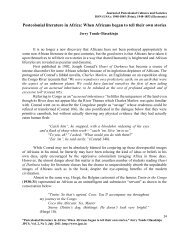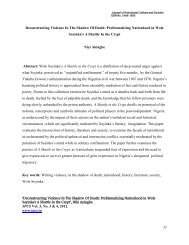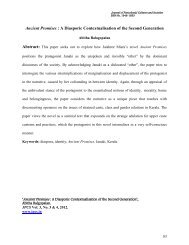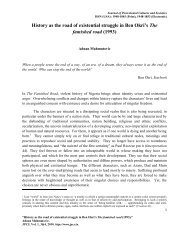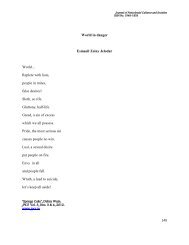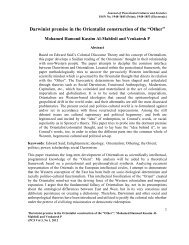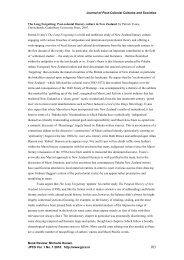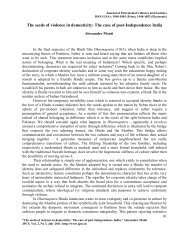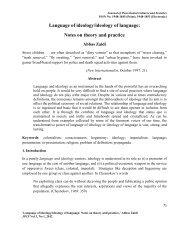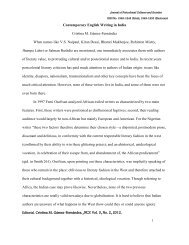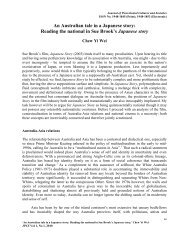'Crossing Thresholds': Radical Notes in Women's Writings ... - JPCS
'Crossing Thresholds': Radical Notes in Women's Writings ... - JPCS
'Crossing Thresholds': Radical Notes in Women's Writings ... - JPCS
Create successful ePaper yourself
Turn your PDF publications into a flip-book with our unique Google optimized e-Paper software.
Journal of Postcolonial Cultures and SocietiesISSN No. 1948-1845 (Pr<strong>in</strong>t); 1948-1853 (Electronic)Cross<strong>in</strong>g thresholds:<strong>Radical</strong> notes <strong>in</strong> women’s writ<strong>in</strong>gs from contemporary South AsiaMadhu S<strong>in</strong>ghThe impetus for this paper came, unexpectedly, from a news report published <strong>in</strong> one ofthe lead<strong>in</strong>g national dailies of India about women‘s non-conformity to stereotypical roles<strong>in</strong> terms hitherto unthought-of. Though tucked <strong>in</strong>nocuously amidst news of greaterimportance, it caught attention because of its unusual subject matter -- someth<strong>in</strong>g that thecivil society <strong>in</strong> India (read the Indian subcont<strong>in</strong>ent) cr<strong>in</strong>ges to talk about openly anddiscretely tries to shove it under the rug. An eye opener, the reportage went like this (notquoted verbatim):It is 6 pm <strong>in</strong> Sangli, the sugar bowl of southern Maharashtra and the city that is secondonly to Mumbai (erstwhile Bombay) <strong>in</strong> its numbers of HIV/AIDS patients. As theeven<strong>in</strong>g descends, the red light area <strong>in</strong> Sangli's Swaroop Talkies locality swarms withcustomers and clients look<strong>in</strong>g for nocturnal ‗pleasure‘ trips. But, Amirbi ShikandarSheikh popularly knows as Awwa,( mother <strong>in</strong> their local language Kannada) sits like aguard dog, fiercely prevent<strong>in</strong>g an eager customer from enter<strong>in</strong>g the red light area at thistime when her students (girls- young and not so young) are pa<strong>in</strong>stak<strong>in</strong>gly learn<strong>in</strong>g thethree R‘s. They are the students of India‘s first school of sex workers and she, the ‗scarletschool mistress‘. Awwa holds the man by his collar, variously shower<strong>in</strong>g H<strong>in</strong>di, Kannadaand Marathi abuse on him, then watch<strong>in</strong>g with some satisfaction as he makes a hastygetaway. She then orders customers already present on the scene to stand up straight forthe national anthem at India's first school for sex workers. It is a signal that class is overfor the day and time for the sex workers to start ply<strong>in</strong>g their trade.‘Cross<strong>in</strong>g thresholds: <strong>Radical</strong> notes <strong>in</strong> women’s writ<strong>in</strong>gs from contemporary South Asia,’Madhu S<strong>in</strong>gh<strong>JPCS</strong> Vol 2 No 4, December 201179
Journal of Postcolonial Cultures and SocietiesISSN No. 1948-1845 (Pr<strong>in</strong>t); 1948-1853 (Electronic)Without any help from the NGOs or the government, s<strong>in</strong>gle handedly she has been ableto run the school successfully for the last five years and cont<strong>in</strong>ues to empower theseunprivileged ‗deviant‘ women. On a nostalgic and reflective note, Amirbi says:When we started the school people laughed at us. Especially the regularcustomers who said it's a nautanki,(farce) which will end <strong>in</strong> few days. Some saidthat we were do<strong>in</strong>g it to get funds. When we started classes <strong>in</strong> the even<strong>in</strong>g, thecustomers said that noth<strong>in</strong>g would happen even if we got graduate degrees asonce a sex worker always a sex worker. There is no way out from our profession.But we don't bother what the world says. It's a fight for our dignity. My eyes werefull of tears when for the first time, I had a pen <strong>in</strong> my hand and signed <strong>in</strong> anotebook. (The Times of India, Feb. 6, 2011)This small but no less significant assertion of their desire to be literate aga<strong>in</strong>st heavy oddswas, <strong>in</strong>deed, commendable. L<strong>in</strong>k<strong>in</strong>g the idea of protest, resistance, and non conformitywith the notion of transgression of boundaries, I <strong>in</strong>tend to study multiple fem<strong>in</strong>iststrategies of ‗threshold cross<strong>in</strong>gs‘ <strong>in</strong> the context of women‘s writ<strong>in</strong>gs <strong>in</strong> South Asia.The notion of ‗threshold‘ <strong>in</strong>dicates the restricted periphery of the woman‘s place <strong>in</strong>family and society. Hence, ‗Cross<strong>in</strong>g Thresholds‘ serves a strong metaphoric functionboth <strong>in</strong> the context of women‘s writ<strong>in</strong>g and <strong>in</strong> the exegetical reflections. It is oftenequated with deviance and transgression and also freedom <strong>in</strong> the modern context <strong>in</strong> asociety that imposes behavioural conformity on its women <strong>in</strong> both metaphorical andliteral sense. However, contrary to the popular Western perception of Indian women as‗passive‘ and ‗eternal‘ victims, and ―paralyzed by a sense of helplessness‖ (Murray1987)women writers have written consistently and mov<strong>in</strong>gly about negotiat<strong>in</strong>g and resist<strong>in</strong>gmultiple patriarchies and <strong>in</strong>ternal colonization. Through these acts of ‗thresholdcross<strong>in</strong>gs‘, they chose to ‗transgress‘ patriarchal boundaries and articulate radical viewson urgent socio-political issues and also on sexual politics. The present paper, thus,‘Cross<strong>in</strong>g thresholds: <strong>Radical</strong> notes <strong>in</strong> women’s writ<strong>in</strong>gs from contemporary South Asia,’Madhu S<strong>in</strong>gh<strong>JPCS</strong> Vol 2 No 4, December 201180
Journal of Postcolonial Cultures and SocietiesISSN No. 1948-1845 (Pr<strong>in</strong>t); 1948-1853 (Electronic)attempts to extend this evocative and emotive notion of threshold cross<strong>in</strong>g by <strong>in</strong>terpret<strong>in</strong>gand equat<strong>in</strong>g it witha. transgression, subversion or devianceb. assertion of women‘s agency for social change andc. freedom from social , economic and political ‗unfreedoms‘(Sen 2000)The writ<strong>in</strong>gs of South Asian women, despite a heavy hand of official and unofficialcensorship, reveal an <strong>in</strong>tricate <strong>in</strong>terweav<strong>in</strong>g of the political and the personal. By‗personal‘ I mean ,what Chandra Talpade Mohanty ma<strong>in</strong>ta<strong>in</strong>s, not someth<strong>in</strong>g ―as‗immediate feel<strong>in</strong>gs expressed confessionally‘ but as someth<strong>in</strong>g that is deeply historicaland collective -- as determ<strong>in</strong>ed by our <strong>in</strong>volvement <strong>in</strong> collectivities and communities andthrough political engagements‖ (Mohanty 2003: 191). These acts of defiance, bothorganized and anonymous, serve as powerful tools of political/personal <strong>in</strong>tervention.Literature can act as a radical tool for op<strong>in</strong>ion formation, provid<strong>in</strong>g deep, mean<strong>in</strong>gfulunderstand<strong>in</strong>g of the problems, conflicts and struggles of South Asian societies. Manyscholars and authors have focused on South Asia but not much attempt has been made tosee the contemporary South Asia through women‘s eye. The fem<strong>in</strong>ist vision of socialtransformation and change has been observed <strong>in</strong> the textual creativity and <strong>in</strong> the writ<strong>in</strong>gpractices of women writers of South Asia.This fem<strong>in</strong>ist practice of ‗look<strong>in</strong>g at‘ the worldcritically and creatively stems from a deeply collective nature of fem<strong>in</strong>ist thought andalso by the fact that ‗be<strong>in</strong>g a woman has political consequences <strong>in</strong> the world we live <strong>in</strong>(Mohanty 2003:3). Recent years have seen women writers from this region far bettervisibility <strong>in</strong> literary doma<strong>in</strong> with the open<strong>in</strong>g up of Indian offices by foreign publisherslike Pengu<strong>in</strong> and Harper Coll<strong>in</strong>s which gave them opportunity and a platform to expressthemselves . With the Booker Prize to Arundhati Roy for The God of Small Th<strong>in</strong>gs, theOnassis International Competition Prize to Manjula Padmanabhan for Harvest and thePulitzer Prize to Jhumpa Lahiri for Interpreter of Maladies, women writers' creativity hasreceived <strong>in</strong>ternational recognition.‘Cross<strong>in</strong>g thresholds: <strong>Radical</strong> notes <strong>in</strong> women’s writ<strong>in</strong>gs from contemporary South Asia,’Madhu S<strong>in</strong>gh<strong>JPCS</strong> Vol 2 No 4, December 201181
Journal of Postcolonial Cultures and SocietiesISSN No. 1948-1845 (Pr<strong>in</strong>t); 1948-1853 (Electronic)Also, the emergence of fem<strong>in</strong>ist publish<strong>in</strong>g houses such as Kali for Women, Stree,Zubaan ,Women Unlimited aspart of the global women‘s and women‘s studiesmovements, created space for fem<strong>in</strong>ist voices and participated <strong>in</strong> fem<strong>in</strong>ist activism.Pioneer<strong>in</strong>g fem<strong>in</strong>ist scholars and activists <strong>in</strong> South Asia and abroad such as B<strong>in</strong>aAgarwal, Paola Bacchetta, Kamla Bhas<strong>in</strong>, Radhika Chopra, Radhika Coomaraswamy,Neloufer de Mel, Zillah Eisenste<strong>in</strong>, Rada Ivekovic, Indira Jais<strong>in</strong>g, Kumari Jayawardena,Kalpana Kannabiran, Nighat Said Khan, Fatima Mernissi, Chandra Mohanty, MarthaNussbaum, Rajeswari Sunder Rajan, Shahnaz Rouse, Vandana Shiva and Romila Thapar;and the f<strong>in</strong>est creative writers <strong>in</strong>clud<strong>in</strong>g Bama, Ismat Chughtai, Esther David, MridulaGarg, Qurratula<strong>in</strong> Hyder and Nayantara Sahgal were published by these women<strong>in</strong>itiatives <strong>in</strong> pr<strong>in</strong>t culture. Still there is a grow<strong>in</strong>g need to br<strong>in</strong>g to light writ<strong>in</strong>gs withfem<strong>in</strong>ist commitment to social and economic justice and female sexuality by focus<strong>in</strong>g onautonomous concerns and strategies which are historically, politically, and culturallygrounded.The present paper is an attempt to <strong>in</strong>vestigate and explore the not- so- large butdist<strong>in</strong>ctive body of contemporary progressive literature by women <strong>in</strong> South Asia and itsengagement with the issues of caste, religion, ethnicity, sexuality, ecology and genderedviolence keep<strong>in</strong>g <strong>in</strong> m<strong>in</strong>d the specificities of these issues with<strong>in</strong> different contexts thatconstitute ‗South Asia‘ and also the shared, unequal, and overlapp<strong>in</strong>g histories of theregion. (The term ―South Asia‖ is now applied to what, <strong>in</strong> colonial days, was commonlyknown as the ―Indian subcont<strong>in</strong>ent‖ – a diverse mix of British India and a range of k<strong>in</strong>gdomswith vary<strong>in</strong>g degrees of subservience and fealty to the colonial power.) This means thatthere is a need to explore ―race, class, gender, nation, sexuality, and colonialism not just<strong>in</strong> terms of static, embodied categories but <strong>in</strong> terms of histories and experiences that tie ustogether—that are fundamentally <strong>in</strong>terwoven <strong>in</strong>to our lives‘ (Talpade 191). And also, toth<strong>in</strong>k relationally about questions of power, equality, and justice, the need to be <strong>in</strong>clusive<strong>in</strong> our th<strong>in</strong>k<strong>in</strong>g, and the necessity of our th<strong>in</strong>k<strong>in</strong>g and organiz<strong>in</strong>g be<strong>in</strong>g contextual, deeplyrooted <strong>in</strong> questions of history and experience‖(192)‘Cross<strong>in</strong>g thresholds: <strong>Radical</strong> notes <strong>in</strong> women’s writ<strong>in</strong>gs from contemporary South Asia,’Madhu S<strong>in</strong>gh<strong>JPCS</strong> Vol 2 No 4, December 201182
Journal of Postcolonial Cultures and SocietiesISSN No. 1948-1845 (Pr<strong>in</strong>t); 1948-1853 (Electronic)The texts used <strong>in</strong> the present paper are either English translations from different SouthAsian ‗vernaculars‘ or <strong>in</strong>digenous writ<strong>in</strong>gs <strong>in</strong> English. The reason for not <strong>in</strong>clud<strong>in</strong>g thecosmopolitan young women writers <strong>in</strong> English though far more accessible and visible orthe South Asian diaspora (with their attendant immigrant life and/or sensibilities),<strong>in</strong>stead, opt<strong>in</strong>g for those who write <strong>in</strong> regional languages or ‗vernacular‘ (even thoughtheir works may be accessed through translation) is that the latter‘s writ<strong>in</strong>gs arepreoccupied with cont<strong>in</strong>gent realities and grass root experiences that are often unknownto even to a majority of South Asians.This paper argues for a different academic practice <strong>in</strong> relation to women‘s writ<strong>in</strong>gs andacknowledges their specifically literary and <strong>in</strong>tellectual contributions of activisms. Thewriters selected for the purpose are from India, Pakistan, Bangladesh, and Sri Lanka.Their writ<strong>in</strong>gs go beyond the domestic spheres of 'hearth and home 'and they themselvesfreely and boldly on a variety of themes. Though there may still be cases of theoccasional male envy, these new writers are not hold<strong>in</strong>g back <strong>in</strong> express<strong>in</strong>g the po<strong>in</strong>t ofview from a fem<strong>in</strong><strong>in</strong>e eye without adopt<strong>in</strong>g fem<strong>in</strong>ist postures. Or, as poetess RukmaniBhaya Nair puts it, " Have wrung poems from households tasks/carry<strong>in</strong>g water, child,sorrow... The issues that occupy these writers are no longer fem<strong>in</strong>ist or chauv<strong>in</strong>istic, but,socio- political issues of everyday life.One of the earliest <strong>in</strong>stances of ‗literary radicalism‘ <strong>in</strong> the Indian Subcont<strong>in</strong>ent , to usethe phrase made popular by Priyamvada Gopal <strong>in</strong> her now famous work Literary<strong>Radical</strong>ism <strong>in</strong> India: Gender, Nation and Transition to Independence (2005) goes back tothe turbulent years of India‘s anticolonial struggle .The year was 1931 when Dr RashidJahan a Muslim young ‗lady doctor‘ from a progressive family contributed two of herstories: ‗Dilli ki Sair‘(A Visit to Delhi) and ‗Parde ke Peeche‘(Beh<strong>in</strong>d the Veil) to anUrdu anthology Angare (Live Embers). Angare was edited by Sajjad Zaheer andconta<strong>in</strong>ed radically progressive short stories and plays by Zaheer, Ahmed Ali, RashidJahan and Mahmuduzzafar .These writers were young and charged with the desire tochange the world, and the anthology was an attempt to shock the reader <strong>in</strong>to a new‘Cross<strong>in</strong>g thresholds: <strong>Radical</strong> notes <strong>in</strong> women’s writ<strong>in</strong>gs from contemporary South Asia,’Madhu S<strong>in</strong>gh<strong>JPCS</strong> Vol 2 No 4, December 201183
Journal of Postcolonial Cultures and SocietiesISSN No. 1948-1845 (Pr<strong>in</strong>t); 1948-1853 (Electronic)awareness. Angare was pr<strong>in</strong>cipally concerned with social and economic justice, but thetreatment of sexuality, as well as its discussion of the issues that were always pushesbeh<strong>in</strong>d the veil was also provocative.Rashid Jahan‘s stories shot her <strong>in</strong>to prom<strong>in</strong>ence as they were an expose of the evils offeudal patriarchy and domestic misery. To quote Priyamvada Gopal : ―Rashid Jahan -asa woman and as a doctor- writ<strong>in</strong>g about gender, medic<strong>in</strong>e and the politics of space,became an icon of the literary radicalism of Angare itself , decried by some andcelebrated by others‖ . ―In progressive families she became a symbol of the emancipatedwoman; <strong>in</strong> conservative homes an example of all the worst that can occur if a woman iseducated, not kept <strong>in</strong> purdah, and allowed to pursue a career‘ (Zubair and Coppola 1987:170) Structured as a conversation between the women <strong>in</strong> purdah, ‗Parde Ke Piche‘discussed the oppressive domesticity, and the tyranny and <strong>in</strong>fidelity of husbands and theirfrequent divorce threats even for trivial reasons. It also spoke about the ‗hithertounnameable acts‘ <strong>in</strong> upper class Muslim homes: reproductive, systems, foetuses,breastfeed<strong>in</strong>g, sexual practices, sexual abuse, and contraception and otherunacknowledged problems affect<strong>in</strong>g women‘s health. This ‗unveil<strong>in</strong>g‘ of ‗the mystiqueand silence that enshrouds the female body and lett<strong>in</strong>g out the ‗secrets‘ of zenanaoutraged people who threatened Rashid Jahan of dire consequences if she did not retract.The ‗unmediated truths‘ of the private domestic space came out <strong>in</strong> the open as a result ofher dar<strong>in</strong>g act of expos<strong>in</strong>g patriarchal and cultural oppression and by speak<strong>in</strong>g for the‗other‘ and even about the ‗other‘. Years later, another radical Urdu writer writer, IsmatChugtai recalled <strong>in</strong> a 1986 <strong>in</strong>terview:Rashid Jahan shook me up. I stored up her work like pearls… The handsomeheroes and pretty hero<strong>in</strong>es of my stories, the candlelike figures, the lime blossomand the crimson outfits all vanished <strong>in</strong>to th<strong>in</strong> air. The earthy Rashid Jahanshattered all my ivory idols <strong>in</strong>to pieces… Life, stark naked, stood before me.‖‘Cross<strong>in</strong>g thresholds: <strong>Radical</strong> notes <strong>in</strong> women’s writ<strong>in</strong>gs from contemporary South Asia,’Madhu S<strong>in</strong>gh<strong>JPCS</strong> Vol 2 No 4, December 201184
Journal of Postcolonial Cultures and SocietiesISSN No. 1948-1845 (Pr<strong>in</strong>t); 1948-1853 (Electronic)A few years after the Angare fracas and the furor over Rashid Jahan‘s gendered<strong>in</strong>subord<strong>in</strong>ation, Ismat Chugtai‘s story ‗Lihaf‘(The Quilt)created another controversy bypresent<strong>in</strong>g what was considered as ―the most suggestive and sensual representations ofhomoeroticism <strong>in</strong> modern Indian fiction‘ (Gopal 64). Neglected by an aristocratichusband who prefers to spend time with beautiful young men, a young bride Begum Janf<strong>in</strong>ds physical and emotional fulfillment <strong>in</strong> her maid. The quilt that covered the twowomen and threw mov<strong>in</strong>g shadows on the wall functioned as a trope for the rework<strong>in</strong>g ofwife‘s oppressive conditions, first <strong>in</strong>to survival and then fulfillment. In 1998, a similartheme was explored <strong>in</strong> Canadian filmmaker Deepa Mehta's controversial film, Fire <strong>in</strong>which the marital crisis of the two sister-<strong>in</strong>-laws Radha and Sita , who end up <strong>in</strong> draw<strong>in</strong>gmutual sustenance <strong>in</strong> a same sex relationship , are resolved through homoerotic pleasure.Lesbianism, therefore, unlike its Western reflection, takes on the connotations of anunequal power relationship, which the two women set out to equalise through their sexual<strong>in</strong>timacy without men.In this paper I have <strong>in</strong>cluded writ<strong>in</strong>gs across the genres by ‗home writers‘ from with<strong>in</strong> theIndian Subcont<strong>in</strong>ent such as, Kamala Das, Mahasweta Devi Saroop Dhruv from India,Kishwar Naheed and Fahmida Riaz from Pakistan, and Taslima Nasr<strong>in</strong> from Bangladesh .Thus, we have a poem by Kamala Das, a short story by Mahasweta Devi, an extract ofprose writ<strong>in</strong>gs of Nasr<strong>in</strong> , and poems by the Pakistani writers .Renowned Indian poet and writer Kamala Das from India, who triggered controversyboth <strong>in</strong> her writ<strong>in</strong>g and her lifestyle, wrote <strong>in</strong> English and Malayalam, the language ofsouthern state of Kerala. The w<strong>in</strong>ner of several national and <strong>in</strong>ternational literary awards,Das wrote frankly and explicitly about sexuality, often outrag<strong>in</strong>g orthodox readers. Herwrit<strong>in</strong>gs most often focused on love and betrayal. Written <strong>in</strong> a confessional mode,Kamala Das‘s poem ―An Introduction‘ , a frequently anthologized piece, depicts her as arebellious poet who searches for cultural-l<strong>in</strong>guistic as well as sexual identity <strong>in</strong> a postcolonialreality whish is so oppressive and overbear<strong>in</strong>g. The first few l<strong>in</strong>es of her poem‘Cross<strong>in</strong>g thresholds: <strong>Radical</strong> notes <strong>in</strong> women’s writ<strong>in</strong>gs from contemporary South Asia,’Madhu S<strong>in</strong>gh<strong>JPCS</strong> Vol 2 No 4, December 201185
Journal of Postcolonial Cultures and SocietiesISSN No. 1948-1845 (Pr<strong>in</strong>t); 1948-1853 (Electronic)‗Introduction‘ <strong>in</strong>troduce her to the reader as someone who is unfamiliar with the Indianpolitics but familiar with the names of the elite political bigwigs who rule the nation. Herstance as a writer who can ‗speak three languages, write <strong>in</strong>/Two, dream <strong>in</strong> one‘ shedslight on her polyglot ease tempered by her desire to be made free to write <strong>in</strong> a languageshe prefers. The politics beh<strong>in</strong>d language is rather irksome to her:Don‘t write <strong>in</strong> English, they said, English isNot your mother-tongue. Why not leaveMe alone, critics, friends, visit<strong>in</strong>g cous<strong>in</strong>s,Every one of you? Why not let me speak <strong>in</strong>Any language I like? The language I speak,Becomes m<strong>in</strong>e, its distortions, its queernessesAll m<strong>in</strong>e, m<strong>in</strong>e alone.It is half English, half Indian, funny perhaps, but it is honest,It is as human as I am human, don‘tYou see? It voices my joys, my long<strong>in</strong>gs, myHopes, and it is useful to me as caw<strong>in</strong>gIs to crows or roar<strong>in</strong>g to the lions, itIs human speech, the speech of the m<strong>in</strong>d that isHere and not there, a m<strong>in</strong>d that sees and hears andIs aware. Not the deaf, bl<strong>in</strong>d speechOf trees <strong>in</strong> storm or of monsoon clouds or of ra<strong>in</strong> or theIncoherent mutter<strong>in</strong>gs of the blaz<strong>in</strong>gFuneral pyre.At a time (<strong>in</strong> the 60‘s) when writ<strong>in</strong>g <strong>in</strong> English was ak<strong>in</strong> to accept<strong>in</strong>g the ideologicalapparatus of empire and writ<strong>in</strong>g <strong>in</strong> vernacular was considered a political act of resistance,Kamala Das chose to write <strong>in</strong> English. She was ―an heir to two poetic traditions, that ofMalayalam whose roots go back <strong>in</strong>to the ancient Tamil Sangam poetry and medievalfolklore, and that of Indian English poetry beg<strong>in</strong>n<strong>in</strong>g with Henry Derozio or ToruDutt…‖ (K. Satchidanandan, ―Transcend<strong>in</strong>g the Body,‖ ―Introduction to Only the SoulKnows How to S<strong>in</strong>g, 9).‘Cross<strong>in</strong>g thresholds: <strong>Radical</strong> notes <strong>in</strong> women’s writ<strong>in</strong>gs from contemporary South Asia,’Madhu S<strong>in</strong>gh<strong>JPCS</strong> Vol 2 No 4, December 201186
Journal of Postcolonial Cultures and SocietiesISSN No. 1948-1845 (Pr<strong>in</strong>t); 1948-1853 (Electronic)From the explicit assertion of l<strong>in</strong>guistic creativity, she moves on to the expression of hersexual identity as a child-woman imposed on her:When I asked for love, not know<strong>in</strong>g what else to askFor, he drew a youth of sixteen <strong>in</strong>to theBedroom and closed the door, He did not beat meBut my sad woman-body felt so beaten.The weight of my breasts and womb crushed me.I shrank pitifully.As a reaction to this male <strong>in</strong>vasion of her body, she defies the normative dress codemeant for women which is a patriarchal strategy to conta<strong>in</strong> women <strong>in</strong>to a stereotypicalmould. Refus<strong>in</strong>g to conform, she took to wear<strong>in</strong>g shirts and her brother‘s trousers, cut herhair short and thus ignored her womanl<strong>in</strong>ess. But the society at large that is out to forcewomen <strong>in</strong>to submission took charge:Dress <strong>in</strong> sarees, be girlBe wife, they said. Be embroiderer, be cook,Be a quarreller with servants. Fit <strong>in</strong>. Oh,Belong, cried the categorizers. Don‘t sitOn walls or peep <strong>in</strong> through our lace-draped w<strong>in</strong>dows.Be Amy, or be Kamala. Or, betterStill, be Madhavikutty. It is time toChoose a name, a role. Don‘t play pretend<strong>in</strong>g games.Don‘t play at schizophrenia or be aNympho. Don‘t cry embarrass<strong>in</strong>gly loud whenJilted <strong>in</strong> love …Trapped <strong>in</strong> a loveless marriage, she takes up a lover, much to the chagr<strong>in</strong> of the peoplearound her. This is her f<strong>in</strong>al act of defiance though tempered with heartbreaks, sorrows,lonel<strong>in</strong>ess and midnight bouts of alcoholism:I met a man, loved him. CallHim not by any name, he is every manWho wants. a woman, just as I am every‘Cross<strong>in</strong>g thresholds: <strong>Radical</strong> notes <strong>in</strong> women’s writ<strong>in</strong>gs from contemporary South Asia,’Madhu S<strong>in</strong>gh<strong>JPCS</strong> Vol 2 No 4, December 201187
Journal of Postcolonial Cultures and SocietiesISSN No. 1948-1845 (Pr<strong>in</strong>t); 1948-1853 (Electronic)Woman who seeks love. In him . . . the hungry hasteOf rivers, <strong>in</strong> me . . . the oceans‘ tirelessWait<strong>in</strong>g. Who are you, I ask each and everyone,The answer is, it is I. Anywhere and,Everywhere, I see the one who calls himself IIn this world, he is tightly packed like theSword <strong>in</strong> its sheath.Go<strong>in</strong>g aga<strong>in</strong>st the social imag<strong>in</strong>ation of a woman as sexually passive, gentle, selfsacrific<strong>in</strong>g, monogamous and as the repository of the honour of the family, the poetnarratornarrates <strong>in</strong> a tone that is unambiguous, forthright, assertive yet somewhat t<strong>in</strong>gedwith despair:It is I who dr<strong>in</strong>k lonelyDr<strong>in</strong>ks at twelve, midnight, <strong>in</strong> hotels of strange towns,It is I who laugh, it is I who make loveAnd then, feel shame, it is I who lie dy<strong>in</strong>gWith a rattle <strong>in</strong> my throat. I am s<strong>in</strong>ner,I am sa<strong>in</strong>t. I am the beloved and theBetrayed. I have no joys that are not yours, noAches which are not yours. I too call myself I.Kamala Das‗s poetry, thus, pulsates with an urgent and compell<strong>in</strong>g need to breakthrough the conventional barriers and establish a new tradition. Helene Cixous oncewrote:Women must write through their bodies, they must <strong>in</strong>vent the impregnablelanguage that will wreck partitions, classes, and rhetorics, regulations and codes,they must submerge, cut through, get beyond the ultimate reserve discourse.(Cixous, 256)In the light of the above statement, it may be argued that Kamala Das‘s non conformistpoetry is a befitt<strong>in</strong>g example of fem<strong>in</strong>ist discourse on woman‘s body.‘Cross<strong>in</strong>g thresholds: <strong>Radical</strong> notes <strong>in</strong> women’s writ<strong>in</strong>gs from contemporary South Asia,’Madhu S<strong>in</strong>gh<strong>JPCS</strong> Vol 2 No 4, December 201188
Journal of Postcolonial Cultures and SocietiesISSN No. 1948-1845 (Pr<strong>in</strong>t); 1948-1853 (Electronic)A prolific fiction-writer, journalist, and activist Mahasweta Devi‘s story ‗The Hunt‘maps the experiences of the 'tribals'( a tribal woman, to be precise) and tribal life underdecolonization. The central female subaltern of the narrative Mary Oraon is a half-Anglo,half-tribal woman who f<strong>in</strong>ds some measure of <strong>in</strong>dependence <strong>in</strong> her outcast status. She isharassed and stalked by a male logg<strong>in</strong>g contractor named Tehsildar S<strong>in</strong>gh who earliercame to her village to buy logg<strong>in</strong>g rights. ‗Wow! What a dish <strong>in</strong> these woods!‘ TahsildarS<strong>in</strong>gh comments when he first set his eyes on Mary Oraon. Despite her resistance to hissexual advances, he cannot forget her. F<strong>in</strong>ally, tired by his ‗tireless s<strong>in</strong>gle-m<strong>in</strong>dedpursuit‘, she <strong>in</strong>vites him on a rendezvous at a secluded place deep <strong>in</strong>to the forest dur<strong>in</strong>gthe annual spr<strong>in</strong>g festival, Janiparab or the ‗festival of justice‘. Accord<strong>in</strong>g to this tribalcustom, gender roles are reversed once every twelve years. Women become hunters whilemen dress up like clowns amidst dr<strong>in</strong>k<strong>in</strong>g and a festive merrymak<strong>in</strong>g. ‗This year is thetwelfth year. Mary will become a hunter <strong>in</strong> this year‘s ritual hunt‘. Rejoiced at theprospect of hav<strong>in</strong>g a long desired tryst with her, Tehsildar S<strong>in</strong>gh lies <strong>in</strong> wait as shereaches the deeply wooded area near the rav<strong>in</strong>e. ‗Today a small th<strong>in</strong>g cannot pleaseMary. She wants to hunt the big beast! A man, tehsildar. She is approach<strong>in</strong>g a rav<strong>in</strong>e.Nobody knows how deep the rav<strong>in</strong>e is. Bottomless, cold darkness‘.At the appo<strong>in</strong>tedrendezvous, as Mary dr<strong>in</strong>ks ‗imported liquor‘ offered by him, thetehsildar is flushed and excited with the urgent expectancy of the moment of union. Marycaresses Tehsildar‘s face, gives him love bites on his lips. There is fire of lust and passion<strong>in</strong> his eyes. Mary watches him and she notices his face change <strong>in</strong>to an animal. She hasmade up her m<strong>in</strong>d:--Now take me?Mary laughed and held him, laid him on the ground. Tehsildar is laugh<strong>in</strong>g. Marylifts the machete, lowers it, lifts, lowers‘.A few million moons pass. Mary stands up. Blood? On her clothes? She‘ll wash<strong>in</strong> the cut. With great deftness she takes the wallet from Tehsildar‘s pocket. A lotof money. A lot of money. She undoes the fold <strong>in</strong> the cloth at her waist and putsthe money with her own sav<strong>in</strong>gs .‘Cross<strong>in</strong>g thresholds: <strong>Radical</strong> notes <strong>in</strong> women’s writ<strong>in</strong>gs from contemporary South Asia,’Madhu S<strong>in</strong>gh<strong>JPCS</strong> Vol 2 No 4, December 201189
Journal of Postcolonial Cultures and SocietiesISSN No. 1948-1845 (Pr<strong>in</strong>t); 1948-1853 (Electronic)Then first she throws the Tehsildar <strong>in</strong> the rav<strong>in</strong>e, his wallet , cigarettes, hishandkerchief. Stone after stone. Hyenas and leopards will come at night, smell<strong>in</strong>gblood. Or they won‘t.Mary comes out. Walks naked to the cut. Be<strong>in</strong>g naked <strong>in</strong> the cut she feels her facefills with deep satisfaction. As if she had been <strong>in</strong>f<strong>in</strong>itely satisfied <strong>in</strong> a sexualembrace. (16)After the ‗big kill‘ she wants her fiancé Jalim. As women dr<strong>in</strong>k, dance and s<strong>in</strong>g aroundthe fire at night and celebrate the Janiparab festival, Mary quietly leaves them and runsfast <strong>in</strong> the dark. She knows the way to Tohri where her fiancé Jalim lives. Then, both ofthem will then escape to some faraway place.She looks back to f<strong>in</strong>d ‗the spr<strong>in</strong>g festival fires … scattered <strong>in</strong> the distance‘ (17). ‗She isnot afraid, she fears no animal as she walks…Today all the mundane blood-conditionedfears of the wild quadruped are gone because she has killed the biggest beast‘ (ibid).Mary, thus, ‗activates ritual <strong>in</strong>to contemporary resistance‘ as she kills her ma<strong>in</strong>streamexploiter-cum-potential rapist as part of the Jani Parab.Mahasweta Devi, <strong>in</strong> conversation with Spivak <strong>in</strong>forms that ‗every event narrated with<strong>in</strong>that story is true‘ (2001: xi). Recollect<strong>in</strong>g the memory of a ‗light sk<strong>in</strong>ned‘ tribal girl <strong>in</strong> ayellow sari, she says:I see her <strong>in</strong> the Tohri market, barga<strong>in</strong><strong>in</strong>g for fruit and other produce, chew<strong>in</strong>gpan(spiced betel leaf), smok<strong>in</strong>g biri(tobacco leaf cigarettes), argu<strong>in</strong>g and alwaysgett<strong>in</strong>g the upper hand. Such a personality. Then I learnt what she had done onJaniparab day <strong>in</strong> order to marry the Muslim boy.(ibid)This <strong>in</strong>cident of a woman‘s assertion is open to multiple <strong>in</strong>terpretations which may besummed up as follows: First, accord<strong>in</strong>g to Mahasweta Devi , Mary ‗ resurrected the realmean<strong>in</strong>g of the annual hunt<strong>in</strong>g festival day by deal<strong>in</strong>g out justice to a crime committed‘Cross<strong>in</strong>g thresholds: <strong>Radical</strong> notes <strong>in</strong> women’s writ<strong>in</strong>gs from contemporary South Asia,’Madhu S<strong>in</strong>gh<strong>JPCS</strong> Vol 2 No 4, December 201190
Journal of Postcolonial Cultures and SocietiesISSN No. 1948-1845 (Pr<strong>in</strong>t); 1948-1853 (Electronic)aga<strong>in</strong>st the entire tribal society‘(Devi 2001: xi). Thus, <strong>in</strong> her we f<strong>in</strong>d the concretealternative to resist and destroy not only the <strong>in</strong>justice of gender politics but also the<strong>in</strong>cursion upon tribal land and forests by feudalism, colonialism, and global capitalism.As a result, the subaltern figure of Mary Oraon become s a metaphor for tribals andmarg<strong>in</strong>alized people all over the globe. The story of Mary‘s resistance also po<strong>in</strong>ts to the‗profound ecological loss‘, ‗complicity of local developers with the forces of globalcapital‘ (Spivak2001:201)Secondly, Mary‘s act of kill<strong>in</strong>g her ardent suitor and sexual harasser and a wealthy loggerTehsildar S<strong>in</strong>gh from the city, is a clear statement of transcend<strong>in</strong>g and destroy<strong>in</strong>g bothpatriarchies that are totally corrupt. Moreover, by this very act, Mary challenges thedom<strong>in</strong>ant structures of middle-class, upper-caste heteronormative fem<strong>in</strong><strong>in</strong>ity andgendered subjectivity. And, f<strong>in</strong>ally, Devi merges the ritual of the tribal women's huntwith Mary's murder of her suitor, suggest<strong>in</strong>g that <strong>in</strong>digenous practices still provide afertile ground for myths that can be deployed to combat contemporary oppressions. As acreative artist, however, she would not like to allow the First World reader to understandher work as an exotic artifact of the Third.Contemporary women's writ<strong>in</strong>g <strong>in</strong> India has moved away from the conf<strong>in</strong>es ofdomesticity to engage with the historical, political and economic dimensions of the publicspace. <strong>Women's</strong> poetry <strong>in</strong> India has responded to communal violence <strong>in</strong> their own way.Writers like Saroop Dhruv ‗transcend their class-religion-region affiliations and adopt acosmopolitan liberal-humanist secular stance to document their anguish (Beniwal andMehta 2011) The creative response from women poets is not merely a gendered responseto escalat<strong>in</strong>g violence <strong>in</strong> the contemporary world and its devastat<strong>in</strong>g toll on women; but ismultifocal, complex and nuanced(ibid). Gujarati poet Saroop Dhruv based <strong>in</strong> Ahmedabadis also a playwright and cultural activist who writes modernist, fem<strong>in</strong>ist and politicallyengaged literature <strong>in</strong> her mother tongue. Her poem ( translated <strong>in</strong>to English) ‗It‘s All <strong>in</strong>My Hands‘ captures the agony of the poet at the communal frenzy and experiences the‘Cross<strong>in</strong>g thresholds: <strong>Radical</strong> notes <strong>in</strong> women’s writ<strong>in</strong>gs from contemporary South Asia,’Madhu S<strong>in</strong>gh<strong>JPCS</strong> Vol 2 No 4, December 201191
Journal of Postcolonial Cultures and SocietiesISSN No. 1948-1845 (Pr<strong>in</strong>t); 1948-1853 (Electronic)dilemma of shared responsibility and commitment of the <strong>in</strong>tellectual and the articulateclass towards the well be<strong>in</strong>g of civic society. Writ<strong>in</strong>g aga<strong>in</strong>st the ‗conspiracy of silence‘,she chooses to ‗retrieve‘ her pen and write ‗without m<strong>in</strong>c<strong>in</strong>g (her) words‘. The poettranscreates the violence torn city <strong>in</strong> the open<strong>in</strong>g l<strong>in</strong>es of the poem:In a momentthe city turns to pebble, stone, dagger, razorru<strong>in</strong>, spark, flame, ashIn a moment,mobs with hammer, pickaxe, shovel and hand grenadepulverise the city.The present br<strong>in</strong>gs back remembrance of the fractured subcont<strong>in</strong>ental history whenpartition was followed by riots and blood shed. Past creeps <strong>in</strong>to the present, old memoriesare raked up by the present violence:My pen collides with the skeletons of historyW<strong>in</strong>ds howl, like the death rattle of corpses wak<strong>in</strong>g from their slumberWhirl<strong>in</strong>g w<strong>in</strong>ds of death shake the very pillars of civilisationHurl<strong>in</strong>g dust <strong>in</strong>to an ebb<strong>in</strong>g faith <strong>in</strong> lifeS<strong>in</strong>k<strong>in</strong>g claws, vomit<strong>in</strong>g blood everywhere.In a moment, vision is bl<strong>in</strong>ded and directions obscured,The sk<strong>in</strong> of humanity flayed offA poet cannot merely rema<strong>in</strong> as a mute spectator or an observer. Despite belong<strong>in</strong>g to themajority community, she writes <strong>in</strong> a tone that is anti-establishment <strong>in</strong> tone and tenor.With this frame of m<strong>in</strong>d she tries to salvage a writer‘s ethical commitment to the society.She has the courage and the determ<strong>in</strong>ation to speak aga<strong>in</strong>st atrocities committed aga<strong>in</strong>sthumanity <strong>in</strong> clear unequivocal terms‘Cross<strong>in</strong>g thresholds: <strong>Radical</strong> notes <strong>in</strong> women’s writ<strong>in</strong>gs from contemporary South Asia,’Madhu S<strong>in</strong>gh<strong>JPCS</strong> Vol 2 No 4, December 201192
I: a poetI cannot exist as a mere reporter.Nor as a court bard.Journal of Postcolonial Cultures and SocietiesISSN No. 1948-1845 (Pr<strong>in</strong>t); 1948-1853 (Electronic)I want to grit my teeth and speak without m<strong>in</strong>c<strong>in</strong>g my wordsabout this conspiracy.But for thatI must retrieve my penfrom a deep dark well —my father‘s well,my ancestral well,the well that is the f<strong>in</strong>al refuge of womenwho dive to their own shameful death.I have to throw <strong>in</strong> a fish<strong>in</strong>g hook, and pull outmy pen, a brand new penwith my hands alone.Women‘s writ<strong>in</strong>g <strong>in</strong> Pakistan is <strong>in</strong>separable from the country‘s politics, and from thebeg<strong>in</strong>n<strong>in</strong>g their writ<strong>in</strong>gs have been characterized by certa<strong>in</strong> toughness. ‗The w<strong>in</strong>ds offem<strong>in</strong>ism and the zeitgeist of postmodern times gave rise to a group of poets <strong>in</strong> India andPakistan who speak <strong>in</strong> a remarkably <strong>in</strong>telligent and confident voice. They may or may nothave studies western fem<strong>in</strong>ism, but they did share dissatisfaction with the status quo, notconcerned so much with the academic or theoretical aspect of gender bias as with itsblatant manifestation <strong>in</strong> the everyday life of a woman <strong>in</strong> the subcont<strong>in</strong>ent. Long years offeudalism coupled with repression by regime fanned and fuelled the smolder<strong>in</strong>g spark ofsuppressed anger.‘Cross<strong>in</strong>g thresholds: <strong>Radical</strong> notes <strong>in</strong> women’s writ<strong>in</strong>gs from contemporary South Asia,’Madhu S<strong>in</strong>gh<strong>JPCS</strong> Vol 2 No 4, December 201193
Journal of Postcolonial Cultures and SocietiesISSN No. 1948-1845 (Pr<strong>in</strong>t); 1948-1853 (Electronic)The last three decades of the 20 th century witnessed the poetry of protest , at times ,vitriolic, often gloomy, but always self-confident. The emergence of Ada Jafarey,Fahmida Riaz, Kishwar Naheed, Zehra Nigah, Parveen Shakir, Sara Shagufta, AzraAbbas, and others on the horizon of poetry marked a new epoch <strong>in</strong> Urdu literature. Someof the poets resisted the stereotyp<strong>in</strong>g of women <strong>in</strong> Urdu poetry as a beloved with fabulousbeauty but with a fickle and callous heart. Their poetry became a vehicle of their dissentand protest aga<strong>in</strong>st exploitation of women by a hypocritical and <strong>in</strong>iquitous society‘(Baig2005:9) Journalists like Zaib-un-Nissa Hamidullah, a columnist for Dawn, the Karachibased newspaper, discovered that women would lose their jobs if they wrote aboutpolitics <strong>in</strong>stead of stick<strong>in</strong>g to the accepted women‘s sphere of domestic issues.A dist<strong>in</strong>ctively fem<strong>in</strong><strong>in</strong>e voice from Pakistan that is <strong>in</strong>novative, defiant, political, and selfaware is that of Kishwar Naheed. Her poetry dared to go beyond the prescribed accepted'fem<strong>in</strong><strong>in</strong>e' realms to <strong>in</strong>clude issues of female sexuality, politics, and social issues. In an<strong>in</strong>terview with Rakhshanda Jalil for the Indian daily The H<strong>in</strong>du (11/4/2001), KishwarNaheed expla<strong>in</strong>ed her writ<strong>in</strong>g as an attempt to redef<strong>in</strong>e the man-woman relationship.Reject<strong>in</strong>g be<strong>in</strong>g branded as a radical or a bohemian, she declared herself ―a realist‖ who―never let herself get pushed around by men or by circumstances‖. The 1961 FamilyLaws ord<strong>in</strong>ance, which had seemed to predict an <strong>in</strong>creas<strong>in</strong>gly happy time for women,were <strong>in</strong> fact drawn up by women. Then <strong>in</strong> 1979 came Zia ul Haq‘s <strong>in</strong>famous HudoodOrd<strong>in</strong>ances, ―which does not differentiate between rape and adultery‖. Educatedprofessional women formed the Women‘s Action Forum (WAF) protest<strong>in</strong>g <strong>in</strong> the streetsaga<strong>in</strong>st Zia‘s laws. They were backed by Pakistan‘s English language Press. Some of thef<strong>in</strong>est women journalists emerged dur<strong>in</strong>g this period Rukhsana Ahmad translated Urdufem<strong>in</strong>ist poetry, associated for many Indians with the fiery verse of Fahmida Riaz andKishwar Naheed. Naheed‘s poem aga<strong>in</strong>st the <strong>in</strong>famous Hudood Ord<strong>in</strong>ances i <strong>in</strong> Pakistan‗We S<strong>in</strong>ful Women‘ appropriately lent its name to a collection of poems by otherfem<strong>in</strong>ist poets. In this anthology, a group of poets from Pakistan, who refuse to conformto both socio-cultural and literary traditions, react to oppression by call<strong>in</strong>g attention to theway <strong>in</strong> which female experiences are policed and controlled by the state.‘Cross<strong>in</strong>g thresholds: <strong>Radical</strong> notes <strong>in</strong> women’s writ<strong>in</strong>gs from contemporary South Asia,’Madhu S<strong>in</strong>gh<strong>JPCS</strong> Vol 2 No 4, December 201194
Journal of Postcolonial Cultures and SocietiesISSN No. 1948-1845 (Pr<strong>in</strong>t); 1948-1853 (Electronic)The follow<strong>in</strong>g poem ‗We S<strong>in</strong>ful Women‘ depicts how ‗cultural production becomes atool of resistance <strong>in</strong> a climate of social repression‘ (Silva 2003:28) and underlies thesignificance of the act of articulation, as opposed to silence or oppression. It is a bold<strong>in</strong>dictment of a society that uses custom, religion and even brute force to keep womendown. The poet writes fearlessly aga<strong>in</strong>st social and political <strong>in</strong>justices and at thematerialism and sham religiosity that she sees around her.It is we s<strong>in</strong>ful womenwho are not awed by the grandeur of those who wear gownswho don't sell our liveswho don't bow our headswho don't fold our hands together.It is we s<strong>in</strong>ful womenwhile those who sell the harvests of our bodiesbecome exaltedbecome dist<strong>in</strong>guishedbecome the just pr<strong>in</strong>ces of the material world.It is we s<strong>in</strong>ful womenwho come out rais<strong>in</strong>g the banner of truthup aga<strong>in</strong>st barricades of lies on the highwayswho f<strong>in</strong>d stories of persecution piled on each thresholdwho f<strong>in</strong>d that tongues which could speak have been severed.It is we s<strong>in</strong>ful women.Now, even if the night gives chase‘Cross<strong>in</strong>g thresholds: <strong>Radical</strong> notes <strong>in</strong> women’s writ<strong>in</strong>gs from contemporary South Asia,’Madhu S<strong>in</strong>gh<strong>JPCS</strong> Vol 2 No 4, December 201195
Journal of Postcolonial Cultures and SocietiesISSN No. 1948-1845 (Pr<strong>in</strong>t); 1948-1853 (Electronic)these eyes shall not be put out.For the wall which has been razeddon't <strong>in</strong>sist now on rais<strong>in</strong>g it aga<strong>in</strong>.Thus, the ‗s<strong>in</strong>ful women‘ of the poem are not overawed by the repressive forces out tosilence voices of dissent; they are ready to defy their diktats and challenge themAnother Pakistani poet who has made a mark <strong>in</strong> the literary world by her outrightnessand defiance is Fahmida Riaz. Her poem ‗Four Walls and a Black Veil‘ (which also bearsthe title of the anthology) is considered to be one of her most controversial poems. Criticslike Aamer Husse<strong>in</strong> have found that this poem can be <strong>in</strong>terpreted as her response to therise of Khome<strong>in</strong>i and events <strong>in</strong> Iran, when Islam was appropriated by the clergy <strong>in</strong> waysthat were designed to hurl women back <strong>in</strong>to the dark ages. Cloistered and conf<strong>in</strong>ed with<strong>in</strong>the four walls, women <strong>in</strong> Islamic society of Pakistan are forced <strong>in</strong>to silent submission andsubjected to suffer<strong>in</strong>g if they defy societal norms.What shall I do Sire, with this black veil?Why do you bestow on me this great favour?I am not <strong>in</strong> mourn<strong>in</strong>g that I should wear itTo show the world my grief. Nor am I sickThat I should hide my shameIn its dark folds…. SireIf you assure my life, may I tell you,Most humbly: There lies, <strong>in</strong> your perfumed chamber,A corpse that st<strong>in</strong>ks. It begs for pityCover that shroudless corpse. Not me.Its stench is everywhere…‘Cross<strong>in</strong>g thresholds: <strong>Radical</strong> notes <strong>in</strong> women’s writ<strong>in</strong>gs from contemporary South Asia,’Madhu S<strong>in</strong>gh<strong>JPCS</strong> Vol 2 No 4, December 201196
Journal of Postcolonial Cultures and SocietiesISSN No. 1948-1845 (Pr<strong>in</strong>t); 1948-1853 (Electronic)Because of her radical stance and courageous voice, Fahmida Riaz suffered wrath of theauthorities and spent a period of self-exile <strong>in</strong> India.Bangladesh emerged as an <strong>in</strong>dependent state at the end of 1971 through a n<strong>in</strong>e monthlong war of <strong>in</strong>dependence aga<strong>in</strong>st the then West Pakistan. But, the Nation-state is yet tohave a uniform civil code regulat<strong>in</strong>g the domestic life of its citizenry, and women <strong>in</strong>particular, irrespective of their affiliations (Pereira2002). Recent years have seen avirulent fundamentalism <strong>in</strong>creas<strong>in</strong>gly manifest<strong>in</strong>g itself <strong>in</strong> Bangladesh. The Bangladeshiwriter Taslima Nasr<strong>in</strong> needs no <strong>in</strong>troduction. Despised by Islamists and fundamentalists,equally loved and loathed by the read<strong>in</strong>g public, considered with caution by secular<strong>in</strong>telligentsia and fellow fem<strong>in</strong>ists, and ultimately banned by the state, the Bangladeshiauthor has the European Parliament‘s Sakharov Prize for Freedom of Thought and theUNESCO Prize for the Promotion of Tolerance and Non–violence. An outspokenfem<strong>in</strong>ist and secularist, Nasr<strong>in</strong> is a stern critic of the role of religion <strong>in</strong> the oppression ofthe women and the poor. She has worked as a physician <strong>in</strong> Bangladesh before her exile <strong>in</strong>Europe and the US s<strong>in</strong>ce 1994.Despite the efforts of the Bangladeshi state to suppress her works on the charges ofreligious offensiveness, immorality and expression of sexuality, Taslima has created aspace for herself <strong>in</strong> Bangladesh‘s literary and public sphere. Her writ<strong>in</strong>gs unsettles theissues of m<strong>in</strong>ority and of women and/<strong>in</strong> religion and br<strong>in</strong>g to the forefront the issue ofliterature and its uneasy negotiation with state politics <strong>in</strong> the postcolonial state. Her novelLajja (1993), a harsh critique of Islamic politics, was the first novel to document m<strong>in</strong>orityrepression <strong>in</strong> Bangladesh literature. Her Selected Columns or Nirbachita Kalam(1993)created waves <strong>in</strong> Bangladesh when first published. Along with Nashto Meyer NashtoGadya(1993) (Fallen Woman‘s Fallen Prose), the two volumes have created a significantniche for Taslima among South Asian fem<strong>in</strong>ist writers. Nirbachita Kalam was awardedthe Ananda Puruskar, one of the most prestigious of West Bengal‘s literary awards.Taslima says: ―My columns had created a storm <strong>in</strong>side offices, outside <strong>in</strong> the Press Club,‘Cross<strong>in</strong>g thresholds: <strong>Radical</strong> notes <strong>in</strong> women’s writ<strong>in</strong>gs from contemporary South Asia,’Madhu S<strong>in</strong>gh<strong>JPCS</strong> Vol 2 No 4, December 201197
Journal of Postcolonial Cultures and SocietiesISSN No. 1948-1845 (Pr<strong>in</strong>t); 1948-1853 (Electronic)<strong>in</strong> literary gather<strong>in</strong>gs. I do not know how to please readers. I simply know how my eyesfill up with tears as I write every column. Every sentence, every word <strong>in</strong> each sentencetakes shape from my heart, not from my pen‖(Nasreen 2004). ―The columns flow fromTaslima‘s belief that "from the dawn of civilisation, humans have been guided by societyand religion. Society and religion have always been owned and directed by men <strong>in</strong> everyage. State and society surely, but religion too had forever dishonoured women‖ (ibid). Inher columns, she builds a strong case for <strong>in</strong>dictment aga<strong>in</strong>st marriage, Vedic diktats,social mores for women, lusty Pirs and holy men and even the Hadish, which propagates:―If a man wishes to be physically united with his wife and calls her, she must come atonce, even if she is cook<strong>in</strong>g‖(ibid). Or, ―If your wife does someth<strong>in</strong>g shameless, banishher from your bed and beat her‖ (ibid). Thus, her assertions <strong>in</strong> the public and privatespheres, her notions of equality and social justice and her fem<strong>in</strong>ist ideas and theories arecrystallized through her <strong>in</strong>domitable spirit <strong>in</strong> the Selected Columns.The discourse of transgression, assertion and resistance presented <strong>in</strong> the paper suggestswomen‘s confrontation with the ‗scripts‘ laid out by the mascul<strong>in</strong>e dom<strong>in</strong>ated system <strong>in</strong>which they are muted ,completely silenced or even elim<strong>in</strong>ated. These fem<strong>in</strong>ist writ<strong>in</strong>gstend to undo such ‗scripts‘ and rewrite the ways <strong>in</strong> which women confront and critiquethe <strong>in</strong>tertw<strong>in</strong>ed power structures of patriarchy and authoritarianism In all the texts dealtwith <strong>in</strong> the paper, writers and their protagonists have crossed the proverbial ‗threshold‘ ofthe female space by critiqu<strong>in</strong>g communalism, question<strong>in</strong>g capitalism, condemn<strong>in</strong>greligious fundamentalism and support<strong>in</strong>g female sexuality for these were not the usual‗womanly‘ topics of discussion and also veered towards immorality and promiscuity.But the time is ripe to accept change, to recognize difference and place it outside a powerrelationship, so that <strong>in</strong>stead of hierarchical structures, equal relationships are madepossible.‘Cross<strong>in</strong>g thresholds: <strong>Radical</strong> notes <strong>in</strong> women’s writ<strong>in</strong>gs from contemporary South Asia,’Madhu S<strong>in</strong>gh<strong>JPCS</strong> Vol 2 No 4, December 201198
Journal of Postcolonial Cultures and SocietiesISSN No. 1948-1845 (Pr<strong>in</strong>t); 1948-1853 (Electronic)BiographyMadhu S<strong>in</strong>gh is Associate Professor <strong>in</strong> the Department of English and Modern EuropeanLanguages <strong>in</strong> the University of Lucknow, India.Works Cited and ConsultedAhmad, Rukhsana. We S<strong>in</strong>ful Women: Contemporary Urdu Fem<strong>in</strong>ist Poetry. London:Women‘s Press, 1991.Baig, Mirza Nehal Ahmad ‗Lift<strong>in</strong>g the Veil‘ <strong>in</strong> Biblio: A Review of Books, vol X nos.7&8 (July –August 2005) 9.Beniwal, Anup and Amrita Mehta.‗Communalism and the Poetic Imag<strong>in</strong>ation: A Studyof Indian English <strong>Women's</strong> Poetry‘. Intersections: Gender and Sexuality <strong>in</strong> Asia and thePacific Issue 25, February 2011Das, Kamala. ‗Introduction‘. New Delhi: Everest Press, 1965.Devi, Mahasweta. ‗The Hunt‘. .Imag<strong>in</strong>ary Maps. Calcutta: Thema, 2001.Dhruv, Saroop.‘It‘s All <strong>in</strong> my Hands‘.http://www.poetry<strong>in</strong>ternational.org/piw_cms/cms/cms_module/<strong>in</strong>dex.php?obj_id=9982Jadhav, Radheshyam. ‗Like every woman, a sex worker should know how to sign‘. TheTimes of India, Feb 6, 2011.Gopal, Priyamvada. Literary <strong>Radical</strong>ism <strong>in</strong> India. New Delhi: Routledge, 2001.Kumaramkandath , Rajeev . ‗Glimpses of the fire: Document<strong>in</strong>g the debates around thefilm Fire‘. The Centre for the Study of Culture and Society, Bangalore .Mohanty, Chandra Talpade. Fem<strong>in</strong>ism without Borders. New Delhi: Kali for Women,2003.Nasr<strong>in</strong>, Taslima. Selected Columns. Trans. Debjani Sengupta .New Delhi: SrishtiPublishers & Distributors, 2004.Pareira, Faust<strong>in</strong>a. The Fractured Scales: The Search for a Uniform Personal Code.Calcutta: Stree, 2002.Satchidanandan, K. Preface. ―Transcend<strong>in</strong>g the Body ―. Only the Soul Knows How ToS<strong>in</strong>g. By Kamala Das. Kottayam: D C Books, 1996.9.Sen, Amartya. Development as Freedom. New Delhi: Oxford University Press, 2000.‘Cross<strong>in</strong>g thresholds: <strong>Radical</strong> notes <strong>in</strong> women’s writ<strong>in</strong>gs from contemporary South Asia,’Madhu S<strong>in</strong>gh<strong>JPCS</strong> Vol 2 No 4, December 201199
Journal of Postcolonial Cultures and SocietiesISSN No. 1948-1845 (Pr<strong>in</strong>t); 1948-1853 (Electronic)Silva, Neluka. ‗Shameless Women: Repression and Resistance <strong>in</strong> We S<strong>in</strong>ful Women:Contemporary Urdu Fem<strong>in</strong>ist Poetry‘. Meridians Vol 3, No 2, 2003.Spivak, Gayatri Chakravorty. Appendix. Imag<strong>in</strong>ary Maps. Calcutta: Thema,2001.Zafar, Manmay. ‗Polic<strong>in</strong>g Literature, Discipl<strong>in</strong><strong>in</strong>g Taslima: State Censorship <strong>in</strong>Postcolonial Bangladesh‘ . Southern Postcolonialisms: the Global south and the ‘New’Literary Representations.ed Sumanyu Satpathy. New Delhi: Routledge, 2009.Zubair, Sajida and Carlo Coppola. ‗Rashid Jahan: Urdu Literature‘s First ‗Angry YoungWoman‘. Journal of South Asian literature 1987, 22(1).i The Hudood was a law <strong>in</strong> Pakistan that was enacted <strong>in</strong> 1979 as part of then military ruler Zia-ul-Haq'sIslamisation process, and replaced/revised <strong>in</strong> 2006 by the <strong>Women's</strong> Protection Bill. It was criticized aslead<strong>in</strong>g to <strong>in</strong>cidents <strong>in</strong> which a woman subjected to rape, or even gang rape, was eventually accused ofZ<strong>in</strong>a (extramarital sex) and <strong>in</strong>carcerated , and defended as punishment orda<strong>in</strong>ed by God and victim ofextremely unjust propaganda.‘Cross<strong>in</strong>g thresholds: <strong>Radical</strong> notes <strong>in</strong> women’s writ<strong>in</strong>gs from contemporary South Asia,’Madhu S<strong>in</strong>gh<strong>JPCS</strong> Vol 2 No 4, December 2011100



